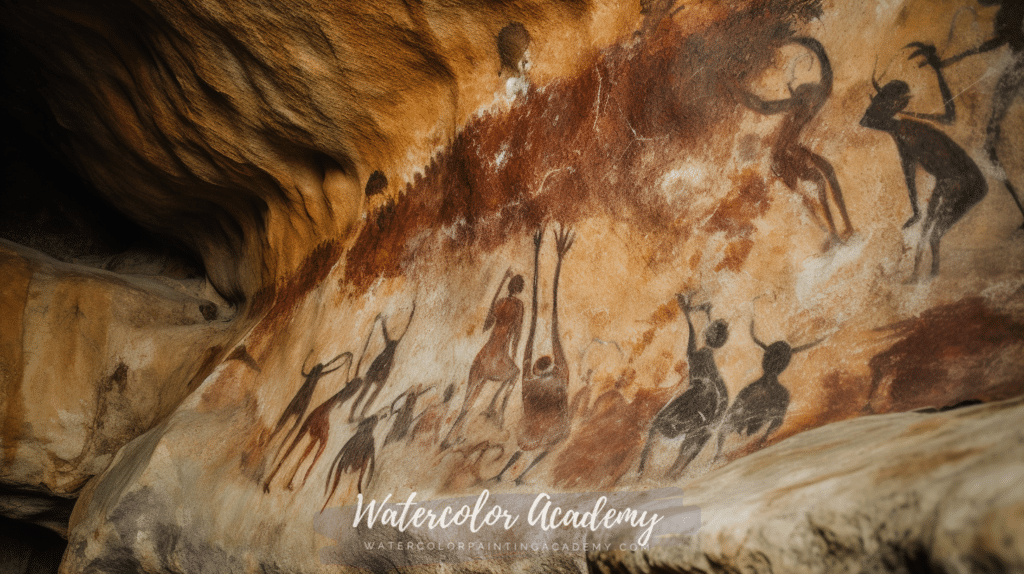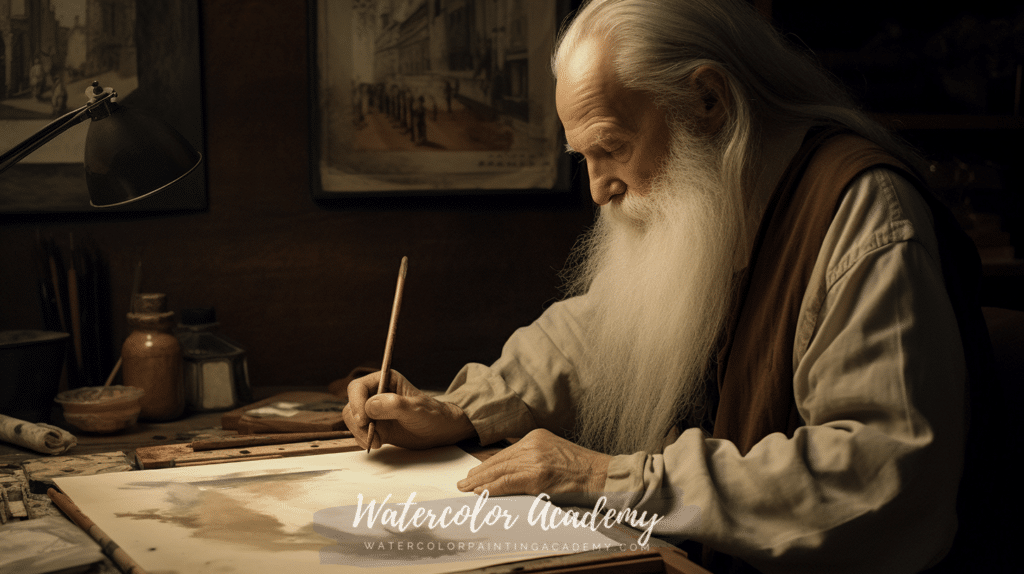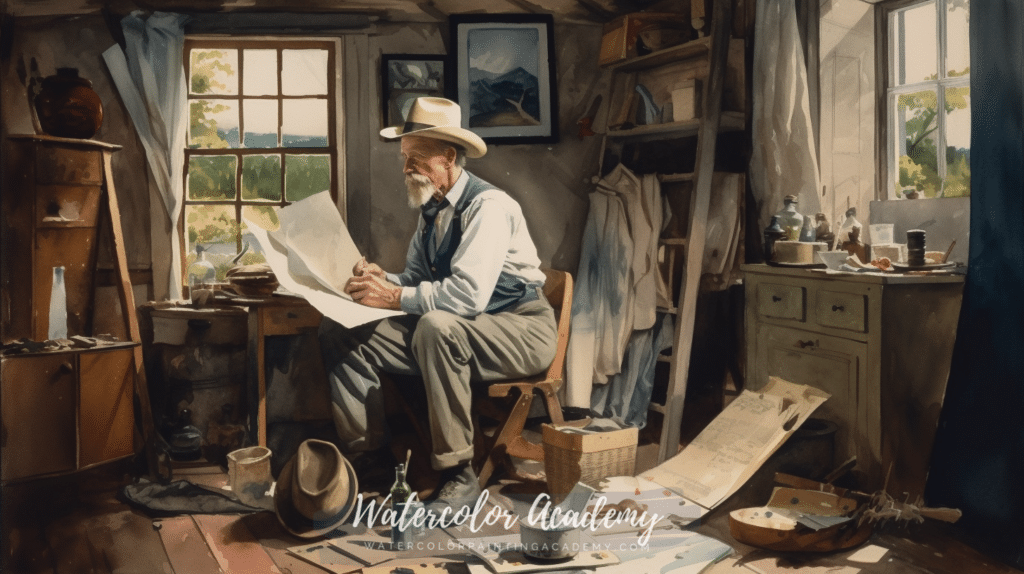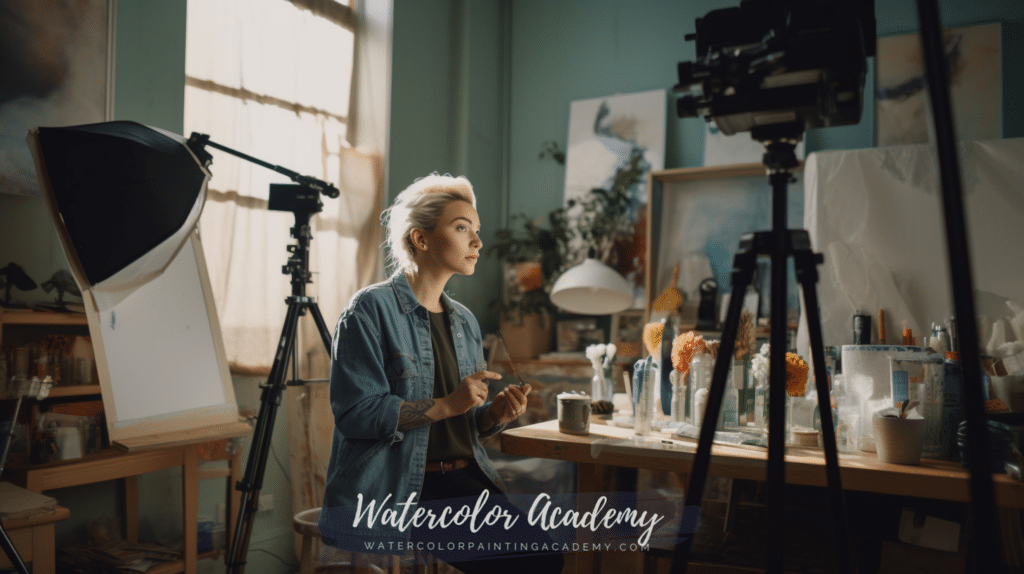Early Beginnings

Cave Paintings
Long before the invention of watercolor paint, we know today our ancestors were creating art using a rudimentary form of watercolor. Early humans created cave paintings by mixing natural pigments with water and applying them to cave walls. These pigments were sourced from materials like ochre and charcoal, and the water helped them adhere to the rough surfaces. The discovery of cave paintings, like those in Lascaux, France, and Altamira, Spain, offers a glimpse into the early origins of watercolor painting.
Ancient Civilizations
As societies evolved, watercolor techniques developed alongside them. The ancient Egyptians used water-soluble pigments to create detailed papyrus art, often used to create the famous Book of the Dead. This early form of the watercolor painting featured intricate designs and a rich color palette, showcasing the impressive skills of ancient Egyptian artists.
In Asia, watercolor techniques were also being refined. Chinese and Japanese artists began to create delicate brushwork paintings on silk and paper, often depicting nature scenes or poetic calligraphy. The use of water-based inks and delicate brushstrokes in East Asian art would go on to influence watercolor painting techniques in later periods.
The early beginnings of watercolor painting demonstrate its enduring appeal and versatility throughout history. As societies and artistic styles continued to evolve, so too did the techniques and materials associated with this art form, paving the way for its development into the medium we know today.
The Emergence of Modern Watercolor

The Middle Ages
Watercolor painting continued to develop during the Middle Ages. Illuminated manuscripts, which were meticulously hand-painted religious texts, often featured watercolor illustrations. Artists used a combination of pigments, water, and a binding agent like gum Arabic to create vivid colors and intricate details.
Renaissance Innovations
The Renaissance was a time of artistic innovation and rediscovery, and watercolor painting was no exception. During this period, artists began experimenting with new pigments and painting techniques. They created detailed studies and sketches, often using watercolor to capture a scene or moment in time quickly.
Famous era artists, such as Albrecht Dürer and Leonardo da Vinci, used watercolor, showcasing the medium’s potential for detailed studies and expressive, gestural brushwork.
The Golden Age of British Watercolor
The 18th and 19th centuries marked a significant turning point for watercolor painting, particularly in Britain. The British watercolor tradition is often called the “Golden Age” due to the incredible work produced by artists during this time.
The growth of the British watercolor movement was fueled by a combination of factors, including the development of new pigments and papers, the rise of the middle class, and a growing interest in landscape painting. Watercolorists such as J.M.W. Turner, John Constable, and Thomas Girtin produced stunning landscape paintings that showcased the medium’s unique qualities, such as its transparency and luminosity.
The Royal Watercolour Society was founded in 1804, further solidifying the importance of watercolor painting in the British art world. Society continues to promote and support watercolor artists to this day.
The evolution of watercolor painting during this period laid the groundwork for the medium’s continued growth and popularity in the following centuries.
Watercolor in the 20th Century and Beyond

The Influence of the American Watercolor Movement
In the 20th century, watercolor painting gained traction in the United States, with artists such as Winslow Homer, John Singer Sargent, and Georgia O’Keeffe embracing the medium. American watercolorists were inspired by British tradition but also sought to develop their unique styles and techniques.
The American Watercolor Society, founded in 1866, played a crucial role in promoting and supporting the growth of watercolor painting in the United States. Exhibitions and workshops organized by the Society helped spread awareness and appreciation for the medium.
The Modernist Movement and Watercolor
The Modernist movement, which emerged in the early 20th century, significantly impacted watercolor painting. Artists like Wassily Kandinsky and Paul Klee experimented with abstract and non-representational forms, pushing the boundaries of traditional watercolor techniques.
Watercolor painting became a popular medium for experimentation among modernist artists, who valued its spontaneity, flexibility, and ability for creating unique visual effects.
Contemporary Watercolor
Watercolor painting continues to evolve today, with contemporary artists exploring new techniques, materials, and subjects. Artists such as Ewa Karpinska, Charles Reid, and Jean Haines have made significant contributions to the medium, pushing the boundaries of what is possible with watercolor.
Contemporary watercolor artists often use the medium to express their unique perspectives and explore a wide range of themes, from abstract concepts to hyper-realistic representations of everyday life.
The continued popularity of watercolor painting can be attributed to its versatility, accessibility, and the beautiful, ethereal qualities it brings to artwork. Watercolor painting remains a beloved and vibrant form of artistic expression as the medium continues to evolve.
The Future of Watercolor Painting

The Role of Technology in Watercolor
As technology advances, it also impacts the world of watercolor painting. Digital art software, such as Adobe Photoshop and Corel Painter, now offer watercolor brushes and tools that simulate the look and feel of traditional watercolor techniques. This has opened up new possibilities for artists who wish to combine traditional and digital methods or create entirely digital watercolor paintings.
Furthermore, online platforms and social media have made it easier than ever for artists to share their work, learn from others, and connect with like-minded individuals. The growing popularity of online tutorials, workshops, and live-streaming sessions has made watercolor techniques and knowledge more accessible to people worldwide.
The Environmental Impact and Sustainability
As awareness of environmental issues grows, artists and art suppliers are increasingly focusing on the sustainability and eco-friendliness of their materials. Watercolor paints, papers, and brushes are no exception. Many manufacturers now offer non-toxic, eco-friendly alternatives to traditional art supplies, ensuring that artists can create beautiful paintings while minimizing their environmental footprint.
Watercolor in Art Education
Watercolor painting is increasingly being recognized as a valuable medium for art education. Schools and art institutions are incorporating watercolor techniques into their curriculums, helping to nurture a new generation of watercolor artists. Watercolor painting is often seen as an accessible and forgiving medium, making it an ideal choice for beginners who wish to explore the world of art.
The Enduring Popularity of Watercolor
Despite the art world’s changes and challenges, watercolor painting remains a popular and cherished medium. Its versatility, beauty, and timeless appeal ensure that it will continue to captivate artists and art lovers for generations to come.
As artists continue to innovate and explore new frontiers in watercolor painting, the medium’s future looks bright and promising. With a rich history and a vibrant present, there’s no doubt that watercolor painting will continue to thrive and inspire artists worldwide.
Conclusion
Watercolor painting is an enchanting and versatile medium with a rich history that spans centuries. Watercolor has always been an essential part of the global art landscape, from its humble beginnings as a means of creating delicate illustrations to its current status as a respected fine art form. As we’ve explored its origins, development, and impact on the art world, it’s clear that watercolor painting has an enduring appeal that continues to captivate both artists and art enthusiasts.
The future of watercolor painting looks brighter than ever, with advancements in technology, a growing focus on sustainability, and an increasing appreciation for the medium in art education. As artists continue to push the boundaries of what’s possible with watercolor, the medium will undoubtedly continue to evolve and inspire new generations of painters. So, whether you’re a seasoned artist or a curious beginner, there’s never been a better time to dive into the world of watercolor painting and discover the magic for yourself.



